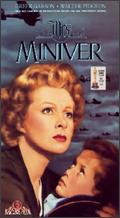Mrs. Miniver
Reviewed by: Brett Willis
STAFF WRITER
| Moral Rating: | Good |
| Moviemaking Quality: |
|
| Primary Audience: | Older Child to Adult |
| Genre: | War Drama |
| Length: | 2 hr. 14 min. |
| Year of Release: | 1942 |
| USA Release: |

| Featuring |
|---|
| Greer Garson, Walter Pidgeon, Teresa Wright, Dame May Whitty, Reginald Owen, Richard Ney, Henry Travers |
| Director |
|
William Wyler |
| Producer |
| William Wyler, Sidney A. Franklin |
| Distributor |
Set in Britain during 1939-41 and released in ‘42, this Best Picture Oscar®-winner was designed to encourage nations to join the Allied cause and to assure those already on board that they’d done the right thing. By focusing on a few fictional families who bravely bear the burden of their country being bombed by the Nazis, it “humanizes” Britain’s struggle and stirs deep emotions. Winston Churchill said that the film’s propaganda value was worth a dozen battleships.
The film opens on happier prewar times during which the upper-middle-class Kay and Clem Miniver (Greer Garson and Walter Pidgeon) spend money freely and are therefore criticized by the titled Lady Beldon (Dame May Whitty) for trying to be “better than their betters.” The spendthrift living and the partly-serious class snobbishness later give way to a spirit of cooperation all around as the Nazi air raids unite the people in a resolve to resist. The film makes the viewer admire Mrs. Miniver and the other lead characters—ordinary people who do what’s necessary in an extraordinary situation. Memorable content: the romance between the Minivers’ son Vin (Richard Ney) and Lady Beldon’s granddaughter Carol (Teresa Wright); the rigged flower show at which Lady Beldon always wins the prize for the best rose; Mrs. Miniver’s confrontation with a downed German pilot; Mr. Miniver’s cheerfulness after his house is bombed (”I was going to redo the dining room anyway”); civilian motorboats crossing the Strait of Dover to rescue troops at Dunkirk.
There’s one instance of implied profanity, which is obscured by a bell ringing. No sexual content. Prejudice between nobles and commoners is shown, but is portrayed negatively. Violence is mostly implied rather than shown. There are two on-screen deaths (one personal but not graphic, the other an anonymous pilot in a burning plane); and other deaths not shown but mentioned in a rousing finale, which injects a nationalist meaning into the hymn “Onward Christian Soldiers.”
Side Notes: Pidgeon made some good career choices, appearing in back-to-back Best Pictures (the 1941 winner was “How Green Was My Valley”). The team of Garson and Pidgeon co-starred in seven films, including being cast again as husband and wife—namely, Pierre and Marie Curie—in the excellent 1943 docudrama “Madame Curie.”



My Ratings: [Good / 2½]